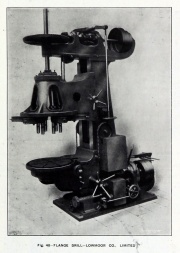Low Moor Co

of Low Moor, Bradford
The business was established by Hird, Jarratt, Dawson and Hardy to utilise the mineral resources in the area. The partners built blast furnaces at Low Moor in 1790. These were constructed by Thomas Woodcock, stonemason and builder. The company engineer at that time was Edward Smalley, from Wigan. Jarratt left the business in 1813. [1]
1791 Company established - Lowmoor Ironworks.
1816 'Iron Boiler. —On Monday last an extraordinary large Iron Boiler, attracted the attention of multitudes of people by being drawn through this city by fifteen horses. It was made at Low Moor Iron Foundery, near Leeds, for Messrs Thornton and Co’s Sugar-House, Hull, to which place it was then proceeding. Its dimensions are 18 feet long, 9 feet wide, and about 6 feet 6 inches high. The weight of this vessel alone was eleven tons, and the carriage on which it was conveyed, is supposed to weigh not less than four tons ; making together a weight of 15 tons. Not being able from its size to pass through Micklegate and Walmgate Bars, it entered the city through Skeldergate ; it however could not be turned near the Bridge, and was therefore taken through North-street, up Tanner-row, and entering Micklegate just within the Bar, proceeded through Castlegate Postern, without much injury being sustained.- York Herald'[2]
1845 8 HP engine made by the 'Low-moor iron company' advertised for sale at the Nan Lane Alum Works in Farnworth, Lancs[3]
1855 'A Yorkshire Projectile for the Crimea. — A tremendous projectile, namely, a 36-inch shell, weighing 26 cwt., cast at the Low Moor iron works, for the Crimea— may be seen at present at the Lancashire and Yorkshire railway station, Wellington-road, Leeds.'[4]
c.1870 Low Moor Ironworks beam engine at the woollen spinning mill of E Illingworth and Co of Shelf Mills, near Bradford, photographed by George Watkins in 1939 [5]
1888 The company was registered on 14 April, to take over the private business of coal and iron masters carried on under the same title. [6]
1914 Iron masters and colliery owners. Specialities: Lowmoor iron, coal, pig iron and coke; iron castings of all sorts; forgings, chains and rivets; mechanical railway signal work; general engineering work. Employees, 3,000. [7]
c.1919 Amalgamated with Robert Heath and Sons. Head Office at Biddulph.
1923 Company by now was called Robert Heath and Low Moor of Bradford.[8]
By 1937 was owned by Thomas W. Ward[9]
By 1966 was part of Midland and Low Moor Iron and Steel Co, a subsidiary of Thomas W. Ward
See Also
Sources of Information
- ↑ 'The Low Moor Ironworks, Bradford' by Charles Dodsworth, Industrial Archaeology, The Journal of the History of Industry and Technology, Vol 8, No. 2, May 1971
- ↑ Perthshire Courier - Thursday 31 October 1816
- ↑ Bolton Chronicle - Saturday 20 October 1849
- ↑ Morning Post, 24 October 1855
- ↑ 'Stationary Steam Engines of Great Britain: Volume 1: Yorkshire'. Landmark Publishing Ltd., 2000
- ↑ The Stock Exchange Year Book 1908
- ↑ 1914 Whitakers Red Book
- ↑ The Engineer 1923/09/21
- ↑ The Times, Oct 01, 1937








